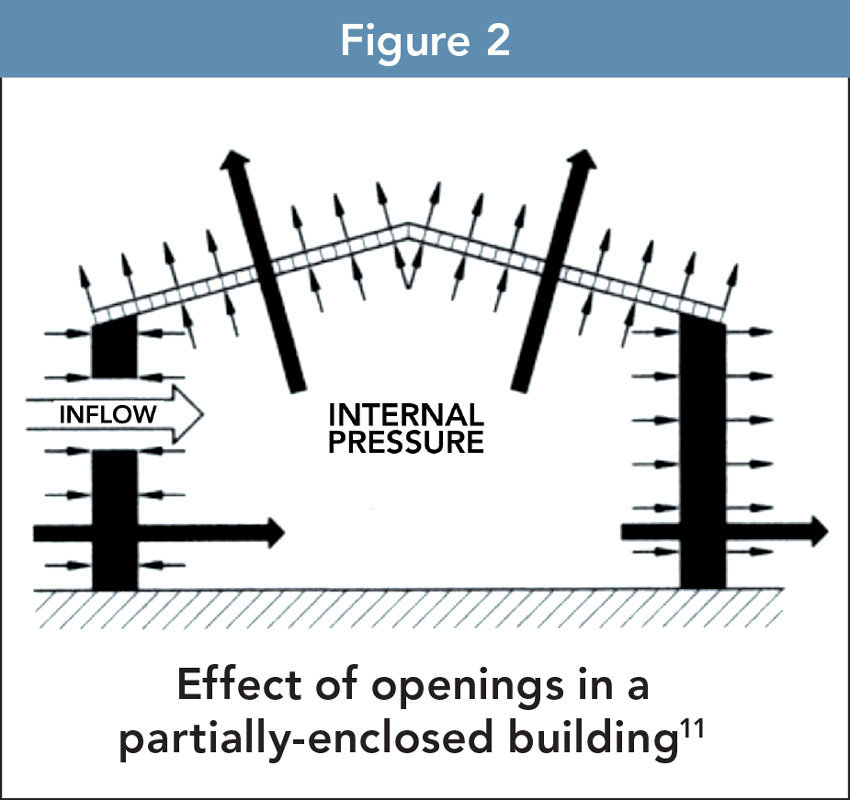Designing for High Winds
Topographic Effects
In calculation of wind loads, topographic effects are accounted for by use of the topographic factor, Kzt. The topographic factor accounts for observations from research and field experience that wind speeds can increase significantly due to topographic effects with the wind speed increase known as a wind speed-up effect. A recognized topographic effect is that buildings located on the upper half of an isolated hill or escarpment may experience increased wind speeds, or wind speed-up, from those for the same building located on level ground. Due to the location-specific nature of the topographic effect, prescriptive solutions for resistance to wind forces are typically based on an assumed topographic effect factor of 1.0.
Wind Directionality
For most wood-frame buildings with wind loads determined in accordance with ASCE 7 load combinations, the effect of wind directionality is accounted for by use of a wind directionality factor, Kd, equal to 0.85. In accordance with ASCE 7 Commentary, the wind directionality factor accounts for two effects: “(1) the reduced probability of maximum winds coming from any given direction and (2) the reduced probability of the maximum pressure coefficient occurring for any given wind direction.”
Elevation Factor
A new elevation factor has been added in ASCE 7-16 that accounts for changes in air density at elevations above mean sea level. The revised standard has a table of Ke factors for elevations up to 6000 ft. and a formula used to calculate the Ke factor for any elevation.
Effect of Openings on Internal Pressure Coefficients
Openings in the building envelope also affect the wind pressures imposed on building elements. The presence of openings in the building envelope can have a significant affect on the magnitude of the total wind pressure required to be resisted by each structural element. Depending on the location and size of openings with respect to wind direction and building porosity, external and internal pressures can act in the same direction to produce higher forces on the walls and roof. An example of this effect of openings is illustrated in Figure below. In this scenario, pressures occur on both exterior and interior building surfaces as a result of a large opening in the windward wall of the building. According to this scenario, wind enters the building, exerting internal pressures (positive) against all interior surfaces. This opening has the net effect of producing high internal pressures that will act in the same direction as the external pressures on the roof and leeward walls, adding to the overall pressure on these building elements.

Image: Florida Building Code Commentary
Effect of openings in a partially-enclosed building11
Buildings are designed as being enclosed, partially enclosed or open. For most buildings, designs are based on the building envelope being enclosed. Open buildings are at least 80% open on every wall. Partially enclosed buildings are buildings in which:
a) The total area of openings in a wall that receives external pressure exceeds the sum of the areas of openings in the balance of the building envelope, and
b) The total area of openings in a wall that receives external pressure exceeds 4 sq ft or 1% of the area of that wall, whichever is smaller, and the percentage of openings in the balance of the building envelope does not exceed 20%.
Enclosed buildings are those that:
- have an opening on the windward wall that is less than 4 sq. ft. or 1% of the area of that wall, and
- where the balance of openings in the building envelope does not exceed 20%.
Windows and doors are not considered openings if they are likely to be closed during a design storm event. Therefore, at a minimum, windows and doors need to be rated to resist the positive and negative design wind pressures. However, in certain hurricane-prone areas there are heightened risks associated with the likelihood of wind-borne debris breaking glazed openings. In such wind-borne debris regions, glazed openings must be impact resistant or protected with an impact-resistant covering, such as shutters, meeting the requirements of an approved impact-resistant standard such as ASTM E1996 and ASTM E1886.









